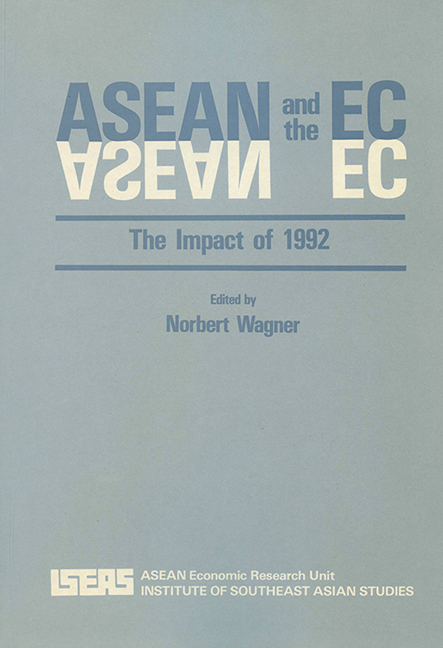Book contents
- Frontmatter
- Contents
- List of Tables
- List of Figures
- Acknowledgements
- PART I INTRODUCTION
- PART II COMPLETING THE EC INTERNAL MARKET
- PART III IMPLICATIONS FOR ASEAN
- V An Analysis of ASEAN-EC Trade in Textiles and Electronics, 1980–88
- VI The EC Internal Market and the ASEAN Electronics Industry
- VII The EC Internal Market and the ASEAN Textile and Clothing Industry
- VIII The Harmonization of Technical Standards and Regulations in the EC: Implications for ASEAN
- IX The EC Internal Market and ASEAN-EC Trade in Services
- X The EC Internal Market and ASEAN-EC Direct Investment Flows
- XI The European Currency System and ASEAN
- Contributors
X - The EC Internal Market and ASEAN-EC Direct Investment Flows
from PART III - IMPLICATIONS FOR ASEAN
Published online by Cambridge University Press: 09 November 2017
- Frontmatter
- Contents
- List of Tables
- List of Figures
- Acknowledgements
- PART I INTRODUCTION
- PART II COMPLETING THE EC INTERNAL MARKET
- PART III IMPLICATIONS FOR ASEAN
- V An Analysis of ASEAN-EC Trade in Textiles and Electronics, 1980–88
- VI The EC Internal Market and the ASEAN Electronics Industry
- VII The EC Internal Market and the ASEAN Textile and Clothing Industry
- VIII The Harmonization of Technical Standards and Regulations in the EC: Implications for ASEAN
- IX The EC Internal Market and ASEAN-EC Trade in Services
- X The EC Internal Market and ASEAN-EC Direct Investment Flows
- XI The European Currency System and ASEAN
- Contributors
Summary
Introduction
The Treaty of Rome in 1957 set the goal of the common market. Internal tariff barriers were removed in 1968. Efforts to dismantle non-tariff barriers to achieve free trade were hampered by the recession of the 1970s. Faced with the prospect of continuing slow growth and threatened by competition from the dynamic Pacific Rim countries, especially the United States, Japan, and the Asian newly industrializing economies (NIEs), the European countries took the decision to accelerate the completion of the common market. In 1985 the European Commission issued a White Paper spelling out a programme and timetable for the abolition of existing trade barriers, harmonization of regulations and tax structures to achieve by the end of 1992 a fully integrated single market, an economic bloc without internal barriers, that is, with free movement of goods, services, people, and capital. Some 300 directives were put forward by the Commission. In 1986 the Single European Act was passed, coming into force in July 1987 and providing the legal basis for the complete dismantling of barriers by the end of 1992.
Countries outside the European Community (EC) are concerned about the emergence of a “fortress Europe”, notwithstanding the repeated assurances by Commission officials and governments of EC Member States. The fear of an emergent fortress Europe stems from the following: Article 115 of the EC Treaty allows national quotas vis-à-vis third countries in exceptional cases; a fully integrated market means that this exemption clause has to be removed. The concern is that this removal can only be achieved at the expense of higher-than-before protection against third countries. The European Commission is in favour of reciprocity to resolve this problem. It may be counter-argued that, as EC exports to non-member countries still account for some 40 per cent of its total exports, a fortress Europe is not in the EC's own interest either.
This chapter focuses only on the implications of the single market on private investment flows for countries of the Association of Southeast Asian Nations (ASEAN). Other aspects of capital flows, albeit important, are not covered.
- Type
- Chapter
- Information
- ASEAN and the ECThe Impact of 1992, pp. 289 - 317Publisher: ISEAS–Yusof Ishak InstitutePrint publication year: 1991

